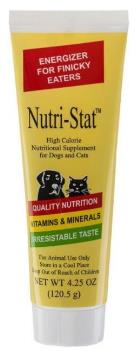Hypoglycemia and Your Puppy
Hypoglycemia is a result of low blood glucose levels and is a challenge not only with the Yorkshire Terrier breed but with all toy breed puppies. Hypoglycemia is a health-related phrase for low blood sugar levels that is a symptom in which there’s an extreme, unexpected decrease in the amount of blood glucose in the puppy.
In tiny breed puppies from after-weaning to 4-month-old, the most prevalent type of hypoglycemia is known as Transient Juvenile Hypoglycemia: “Transient” since the signs or symptoms may be corrected when you eat; “Juvenile” because it’s observed in pups.
Clinical signs of hypoglycemia include weakness, lethargy, poor appetite, altered mentation, twitching, tremoring, seizures and coma. If left untreated, hypoglycemia will be fatal. If an owner suspects hypoglycemia, they can help to increase blood sugar by rubbing a small amount of Karo syrup on the gums, honey, or Nutrical in photos below.
Vets not really acquainted with toy breeds frequently misdiagnose the situation as viral hepatitis or even encephalitis. Being a toy Yorkie breeder as well as dog owner, it is essential to understand the warning signs of hypoglycemia as well as understand how to address it.
Hypoglycemia is handily curable during the early phases, however deadly if it is permitted to advance. Numerous puppy dogs are usually lost unnecessarily to hypoglycemia as a result of lack of knowledge on the part of his/her fur mom/dad or veterinarian.
You should realize that just because a new puppy experiences an occurrence of hypoglycemia, it doesn’t imply that the puppy dog is really “hypoglycemic.” Legitimate hypoglycemia is really a persistent ailment brought on by overproduction of insulin from the pancreas. Although the pancreas may possibly perform correctly, small pups can continue to experience an isolated hypoglycemic occurrence responding to stress or loss of appetite. Pups of any breed of dog are more inclined to acquire hypoglycemia compared to adults, as their skeletal muscle tissue as well as liver size is usually smaller, and their brains are larger, compared with the rest of their body.
Just a short duration of not eating or even anxiety in a toy breed dog may bring about a new hypoglycemic episode. Yorkie puppies with Transient Juvenile Hypoglycemia possess typical liver size as well as functionality, however insufficient glucose precursors or glucose in the saved form (body fat).
Puppies and adult dogs that appear to be in a stupor or coma during a hypoglycemic attack should immediately be given sugar water or an oral concentrated solution of glucose, such as corn syrup or Nutri-Cal. Owners of toy breeds should have a glucose source readily available.
The initial manifestation of hypoglycemia may be that the Yorkshire Terrier puppy may not be as attentive after which it becomes lethargic. Next the pup, will likely then commence to tremble or perhaps shiver. This is usually a response triggered since the brain is deprived for glucose. Additional warning signs of an episode can be a weakness, confusion, shaky stride, frothing, drooling from the mouth area or perhaps even a seizure. His/her body is going to be limp, and lifeless.
The gum area will be pale, nearly a grayish white in color as opposed to a wholesome vibrant pink. If you touch the puppy’s gums with your finger it will feel tacky. The body temperature is going to be below normal and the puppy will most likely be dehydrated. The puppy may go straight into shock and, if it is not taken care of appropriately and rapidly, could even pass away.
Simply put transient juvenile hypoglycemia is a result of not eating enough. What’s important is to determine why the puppy isn’t eating enough. Some of the more common causes for puppies to not eat properly are: Stress, Illness, Activity, Exposure to low temperatures. Click tabs for more info.
Hypoglycemic occurrences are nearly always preceded with a stress of some sort. A few examples associated with typical stresses consist of weaning, teething, inoculations, a change in surroundings, shipping, over-handling, cold environment, intestinal parasitic organisms, bacterial infections, etc.
Our experience is that whenever a puppy isn’t feeling well, they don’t eat as well as when they are feeling normal. Some of the more common illnesses are colds, bacterial infections, reaction to a vaccination, or intestinal parasites such as coccidia, giardia and worms.
Quite a few Yorkie puppies merely play too much and strain their system or perhaps even neglect to eat.
As the environmental temperature is lowered the Yorkie’s metabolism will increase to help maintain their normal body temperature. As their metabolism increases, their need for food increases. If your Yorkie is a marginal eater when the environmental temp. is optimal and when the temperature is below optimal this Yorkie will most likely become hypoglycemic. The optimal environmental temperature for Yorkies is 70 to 74 degrees.
If the Yorkie is slow but can still stand on his/her feet put some Nutri-Cal on your finger and let them lick it off. If you don’t have Nutri-Cal you can put some Karo syrup (clear not brown), or honey in a spoon and let them lick it out of the spoon.
Check temperature of puppy and if below 101 degrees, wrap the Yorkie in a towel or blanket and then use a blow dryer on the towel or blanket. The towel or blanket helps to keep the body heat in the puppy plus it protects the puppy from direct heat of the blow dryer.
Once the Yorkie is alert and can walk on their own let them drink some Pedialyte water. The Pedialyte water helps balance the minerals in the puppy. Use tap water or bottle water if you don’t have Pedialyte water. Usually after suffering a hypoglycemic episode they are also dehydrated.
If they can’t lick your finger or the spoon they are in the more advanced stages of hypoglycemia. Don’t ever force it down their throats. Put the Nutri-Cal, Karo syrup, or honey in a 3-cc. syringe. Syringe a couple of drops into the puppy’s mouth. If the puppy swallows the Nutri-Cal continue putting a couple of drops at a time into the puppy’s mouth. Do this until you have the puppy a total of 1 – 1.5 cc. of Nutri-Cal.
Follow the above procedures for raising body temperature and hydration.
As a preventive measure I recommend leaving food and water out 24 hrs. a day. It is also a good idea to put some Karo (light not dark) syrup or honey in their drinking water. And in some cases, I recommend also giving the puppy Nutri-Cal first thing in the morning and right before going to bed.



